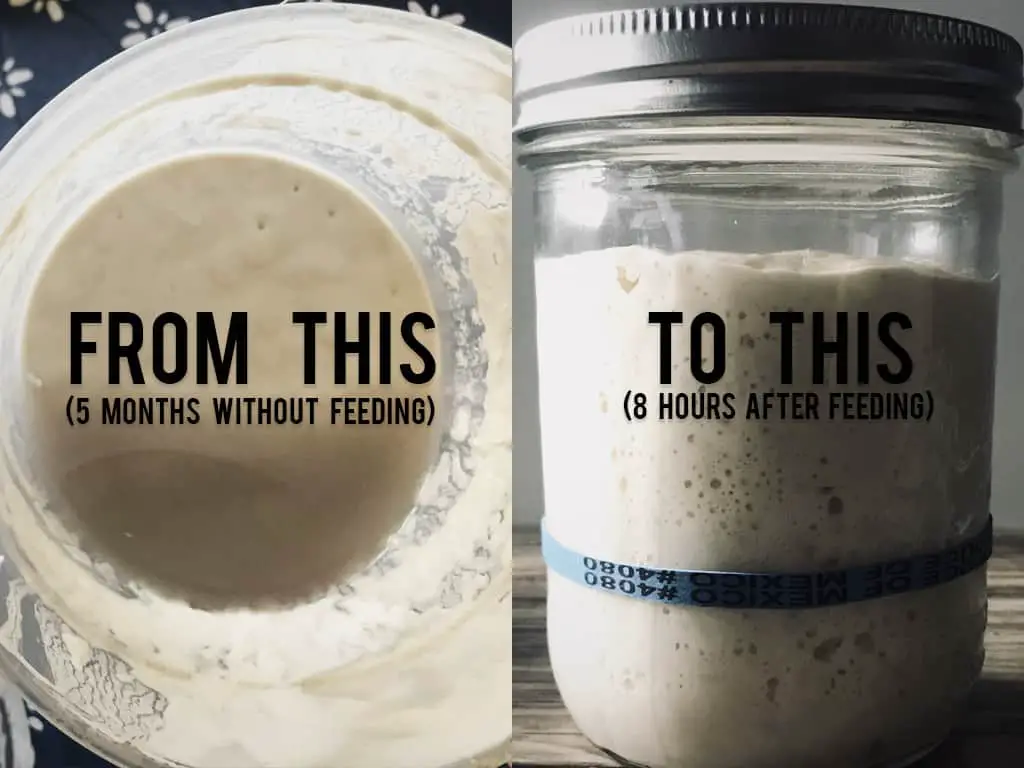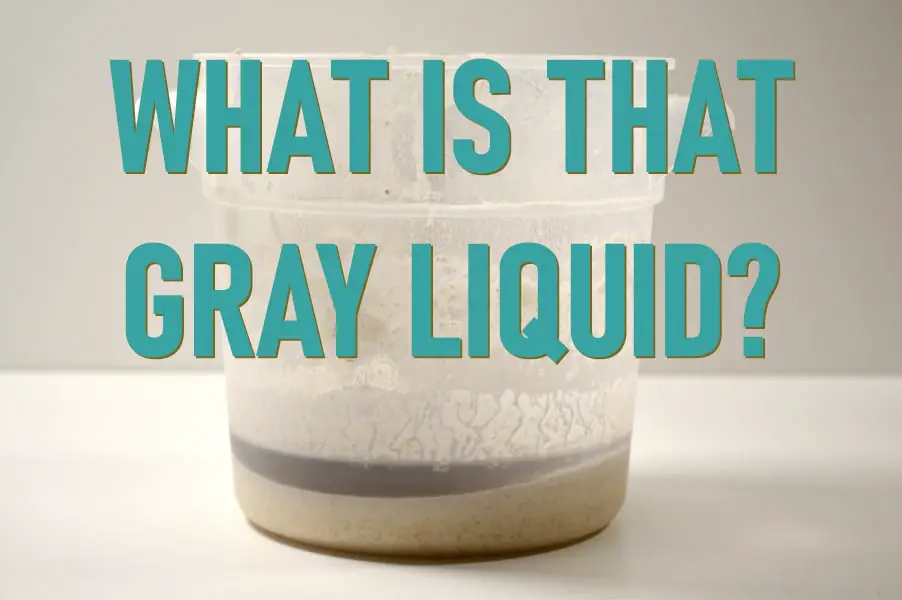I can remember the nervousness I felt when we first saw gray liquid on top of our starter. We’d been warned about it, even told it would happen and not to worry about it. But still, we worried.
Bakers refer to the liquid that accumulates on the top of sourdough starter as “hooch”. That’s because it is an alcoholic byproduct produced by yeast during its fermentation process. Hooch is perfectly safe and simply means a starter hasn’t been refreshed recently. In other words, it’s hungry.
But maybe you’re like us and still a bit worried about it. It just seems so strange in the beginning. In fact, everything about a sourdough starter seemed strange to me in the beginning. 🙂
Let’s take this hooch thing head on. We’re certain you’ll be at ease by the end of this article and have zero worries about hooch again.
Where Does Hooch Come From?
When yeast goes to work consuming starches found in flour, it produces waste in the form of co2 and alcohol. Co2 is what causes the rise to happen as it gets trapped in gluten fibers.
The other byproduct is alcohol which is typically absorbed in the dough and burned off during baking. But when yeast is allowed to ferment for longer periods of time, that alcohol will continue to accumulate and eventually begin to separate from the dough.
Separation happens as co2 escapes from the dough. If you’ve ever observed the normal rise and fall pattern of your starter you can literally see this in action. Due to physics, the alcohol rises to the top as the dough compresses down.
What if My Hooch is Brown, Gray, or Black?

Typically the first layer of hooch that shows up will be clear, or slightly yellow in hue. That is the first sign that your starter is starting to run out of nutrition in the current mixture of water and flour.
How much you fed your starter and how warm or cool you store it determines how long it takes to get to the “hungry” stage. For a typical feeding of the same weight starter to flour to water, we see about 36-48 hours at warmer temps and four to five days in a fridge.
This can vary for many reasons, but those numbers are pretty typical for the first layer of alcohol to show up. But from there, if left unattended much longer then more and more hooch will accumulate and begin turning brown, then gray, and eventually even black.
Those colors are a clear sign that it has been several days, weeks, or months since a starter has been fed. But, they are normal and NOT signs that your starter has gone bad. I know that is hard to believe, but it is the collective opinion of many bakers far more experienced than us.
*Remember, we’re not food safety experts. We’re home bakers. Always use your best judgement, as you’re the only one who can see and smell everything that is going on.
What Should I do With Hooch?
Hooch can be stirred back in, and everything will be just fine. In fact, many individuals suggest stirring it in is a must.
We don’t take that hard stance, and have seen little difference in pouring off hooch or stirring it back in. So we suggest distinguishing between the colors and how you treat them.
Clear Hooch: What we do is stir the clear liquid in when we refresh our starter for baking (honestly though, we bake so often that we rarely see it unless we are testing). Pouring it off does no harm to the starter in our experience, but some suggest it can throw the balance off. We simply stir it in because it’s easier. 🙂
Yellow Hooch: We stir this back in as well, it’s usually just slightly hued yellow for us, and we see no reason to need to dump it out. It removes an added step.
Brown, Gray, and Black Hooch: We pour this hooch off, scrape the top layer off of the starter and then refresh. Our thinking is more along the lines of color than safety. We’ve found mixed opinions on this one. We just don’t want a gray starter.
*Note that when starter has gone this long without a feeding it takes a bit of care to get it back to full strength. We’ll touch on that towards the bottom of this post.
How Do I Avoid Hooch?
The only way to avoid hooch is to feed it before it consumes all of its food supply. If stored in a fridge, you’ll be able to go upwards of a week before seeing much hooch. If left on the counter you’ll likely need to feed it daily to avoid hooch.
You can also give your starter a bit more “food” each time you store it. By that I mean give it twice as much food to the weight of your starter. As an example, if your starter is 50 grams, feed it 100 grams water and 100 grams flour.
Additionally, you can add less water in your starter to make it a more stiff consistency. This is what people refer to as a stiff starter vs a liquid starter that has equal parts water and flour. A common stiff starter uses 60 percent water. This means you might go with 100 grams starter, 100 grams flour, and 60 grams water. Stiff starters tend to take longer to form hooch if any at all.
However, I’ve noticed and this could just be anecdotal, that liquid starters are better at resisting mold than stiff starters. In our experience, mold is the number one starter killer. I think the liquid acts as a natural barrier protecting the starter from harmful contaminants.
If you see mold, usually orange, pinkish, or white, then it’s time to let your starter go. Yeast will likely still be active in there, but mold is mold. We don’t need to address much about mold other than how easily it spreads in dough. Even if you cannot see it anywhere but the top of your dough, there is a strong chance it has spread on the microscopic level inside the dough.
How do I Refresh a Starter That Has Hooch?
If your starter has hooch, it’s pretty hungry and will likely need a couple of feedings before it is vibrant again. But depending on how long it has been since a feeding, you have a couple of options.
If it has only been about a week in a fridge or two days at room temperature since its last feeding, you’ll simply stir the hooch in right along with your fresh flour and water. Your starter will be ready to use in the same amount of time it usually takes to become active.
However, if it has been longer for either of those storage temperatures, you’ll want to give it two feedings. If brown, gray, or black hooch is present we suggest pouring it off and only useing a small portion of starter (about 25-30 grams) and adding 100 grams water and 100 grams flour. We mix in a clean jar and let it sit out at room temp for 24 hours.
Don’t discard the rest of the old starter, keep it in case this new batch doesn’t turn out. We put it in the fridge until we know the new one is good to go.
Just make sure this new offshoot batch rises over the 24 hour period, and you’re ready to move on. If it doesn’t rise, it’s common practice to stir it up without feeding it and let it sit again until you see activity (we’ve never had to go longer than 24 hours).
After at least 24 hours have passed, and you’ve seen rise discard a portion of your starter and give it one more feeding (what your normal recipe calls for). It should be ready to use once it doubles or triples in size (what your starter normally does is the standard).
If after a couple of days you don’t see any signs of life, repeat the process again with the batch you put in the fridge. If it doesn’t work out at this stage, it might be time to start over with a brand new starter.
I really don’t expect that you will have to start over, as sourdough starters are very resilient. The only caveat is if the starter was fairly new when you left it unfed. We’re talking very new here, under a couple of months old. After just a few months of routine feedings, starters become pretty robust.
What if the Hooch Smells Really Bad?
If your hooch smells foul, like something is clearly wrong, then discard it all. We’ve not experienced this yet, but we’ve heard it smells something like really stinky feet or aged cheese.
Regardless of what it smells like, if the odor is off-putting, it’s safe to say that it has gone south. By “it” we mean the whole starter. The foul smell is not just due to the hooch, as it is just a byproduct. The hooch should just smell like strong alcohol, maybe even something close to fingernail polish remover. If there is a foul smell it means the balance of good bacteria in there died off and other harmful intruders made their way in there.
In that event, sadly, it’s time to start from scratch. We’ve got a really simple process of starting a starter in just seven days on average. It uses just whole wheat flour and water. You only have to touch it once a day, and, well, we have a blog post on it here. No need to rewrite the thing. 🙂

